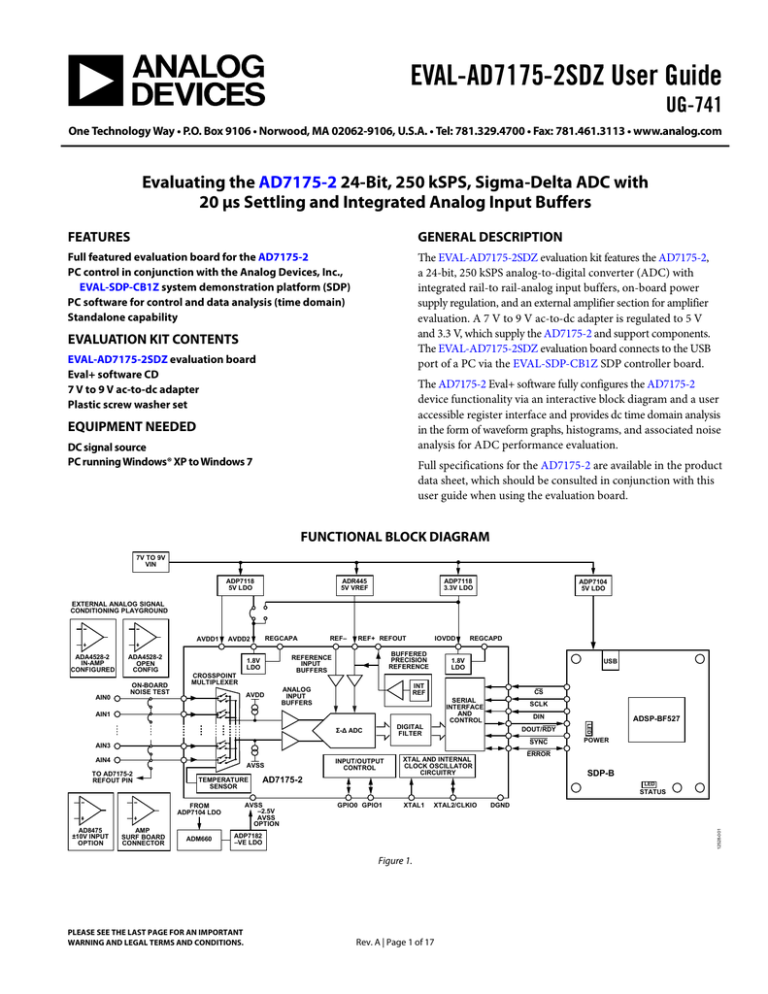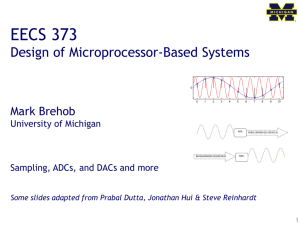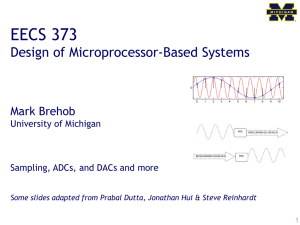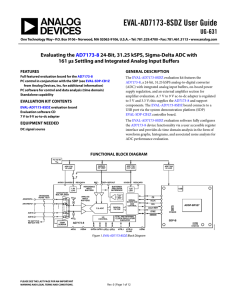EVAL-AD7175-2SDZ User Guide UG-741
advertisement

EVAL-AD7175-2SDZ User Guide UG-741 One Technology Way • P.O. Box 9106 • Norwood, MA 02062-9106, U.S.A. • Tel: 781.329.4700 • Fax: 781.461.3113 • www.analog.com Evaluating the AD7175-2 24-Bit, 250 kSPS, Sigma-Delta ADC with 20 µs Settling and Integrated Analog Input Buffers FEATURES GENERAL DESCRIPTION Full featured evaluation board for the AD7175-2 PC control in conjunction with the Analog Devices, Inc., EVAL-SDP-CB1Z system demonstration platform (SDP) PC software for control and data analysis (time domain) Standalone capability The EVAL-AD7175-2SDZ evaluation kit features the AD7175-2, a 24-bit, 250 kSPS analog-to-digital converter (ADC) with integrated rail-to rail-analog input buffers, on-board power supply regulation, and an external amplifier section for amplifier evaluation. A 7 V to 9 V ac-to-dc adapter is regulated to 5 V and 3.3 V, which supply the AD7175-2 and support components. The EVAL-AD7175-2SDZ evaluation board connects to the USB port of a PC via the EVAL-SDP-CB1Z SDP controller board. EVALUATION KIT CONTENTS EVAL-AD7175-2SDZ evaluation board Eval+ software CD 7 V to 9 V ac-to-dc adapter Plastic screw washer set The AD7175-2 Eval+ software fully configures the AD7175-2 device functionality via an interactive block diagram and a user accessible register interface and provides dc time domain analysis in the form of waveform graphs, histograms, and associated noise analysis for ADC performance evaluation. EQUIPMENT NEEDED DC signal source PC running Windows® XP to Windows 7 Full specifications for the AD7175-2 are available in the product data sheet, which should be consulted in conjunction with this user guide when using the evaluation board. FUNCTIONAL BLOCK DIAGRAM 7V TO 9V VIN ADR445 5V VREF ADP7118 5V LDO ADP7118 3.3V LDO ADP7104 5V LDO EXTERNAL ANALOG SIGNAL CONDITIONING PLAYGROUND AVDD1 ADA4528-2 IN-AMP CONFIGURED AIN0 ADA4528-2 OPEN CONFIG ON-BOARD NOISE TEST REGCAPA AVDD2 REF– REF+ REFOUT REFERENCE INPUT BUFFERS 1.8V LDO CROSSPOINT MULTIPLEXER AVDD IOVDD BUFFERED PRECISION REFERENCE REGCAPD 1.8V LDO USB INT REF ANALOG INPUT BUFFERS CS SERIAL INTERFACE AND CONTROL AIN1 SCLK DIN DOUT/RDY SYNC AIN3 AVSS TO AD7175-2 REFOUT PIN TEMPERATURE SENSOR AD8475 ±10V INPUT OPTION AMP SURF BOARD CONNECTOR ADM660 LED STATUS GPIO0 GPIO1 XTAL1 XTAL2/CLKIO ADP7182 –VE LDO Figure 1. PLEASE SEE THE LAST PAGE FOR AN IMPORTANT WARNING AND LEGAL TERMS AND CONDITIONS. SDP-B AD7175-2 AVSS –2.5V AVSS OPTION FROM ADP7104 LDO INPUT/OUTPUT CONTROL POWER ERROR XTAL AND INTERNAL CLOCK OSCILLATOR CIRCUITRY DGND 12528-001 AIN4 ADSP-BF527 LED DIGITAL FILTER Σ-Δ ADC Rev. A | Page 1 of 17 UG-741 EVAL-AD7175-2SDZ User Guide TABLE OF CONTENTS Features .............................................................................................. 1 Power Supply Configurations ......................................................7 Evaluation Kit Contents ................................................................... 1 Analog Inputs.................................................................................7 Equipment Needed ........................................................................... 1 Reference Options .........................................................................7 General Description ......................................................................... 1 Evaluation Board Software ...............................................................8 Functional Block Diagram .............................................................. 1 Software Installation .....................................................................8 Revision History ............................................................................... 2 Launching the Software ................................................................8 EVAL-AD7175-2SDZ Quick Start Guide ...................................... 3 Software Operation ...........................................................................9 Recommended Quick Start Guide ............................................. 3 Overview of the Main Window ...................................................9 Quick Start Noise Test ................................................................. 3 Configuration Tab (1) ...................................................................9 Evaluation Board Hardware ............................................................ 4 Waveform Tab (15)..................................................................... 12 Device Description ....................................................................... 4 Histogram Tab (26) .................................................................... 14 Hardware Link Options ............................................................... 4 Calculated Performance Tab (29) ............................................ 15 Sockets and Connectors .............................................................. 5 Register Map Tab (34)................................................................ 16 Serial Interface .............................................................................. 6 Exiting the Software ................................................................... 16 Power Supplies .............................................................................. 6 REVISION HISTORY 6/15—Rev. 0 to Rev. A Changed Evaluation Software to Eval+ Software ...... Throughout Changes to Evaluation Kit Contents Section, General Description Section, and Figure 1 ........................................................................ 1 Changes to Quick Start Noise Test Section and Figure 2 ............ 3 Changes to Table 1 ............................................................................ 4 Changes to Table 3 ............................................................................ 6 Changes to Single Supply (Unregulated) Section, Split Supply (Regulated) Section, and Split Supply (Unregulated) Section .... 7 Changes to Evaluation Board Software Section ........................... 8 Changes to Overview of the Main Window Section ................... 9 Added Evaluation Mode (2) Section, Analog Supply Voltage (9 and 13) Section, Digital Supply Voltage (10) Section, Analog Input Voltage (11) Section, External SCLK Frequency (12) Section, and External MCLK Frequency (14) Section ................ 9 Changes to Figure 7 ........................................................................ 10 Added Figure 8; Renumbered Sequentially ................................ 11 Changes to Figure 9 ........................................................................ 13 Changes to Figure 10 ...................................................................... 14 Added Calculated Performance Tab (29) Section, Filter Profile and Response (30 and 31) Section, Performance Summary (32) Section, Timing Diagram (33) Section, and Figure 11 .............. 15 Changes to Figure 12 ...................................................................... 16 11/14—Revision 0: Initial Version Rev. A | Page 2 of 17 EVAL-AD7175-2SDZ User Guide UG-741 EVAL-AD7175-2SDZ QUICK START GUIDE RECOMMENDED QUICK START GUIDE QUICK START NOISE TEST Follow these steps to set up the evaluation board: Use the following procedure to quickly test the noise performance: 1. 1. 3. 4. 5. 6. 2. Insert Link LK8 to Link LK12 to initiate the noise performance test mode. In this mode, analog input channels short to the REFOUT pin. Click Start Sampling to acquire samples from the ADC (see Figure 7). The Samples numeric control in the top right corner of the main window sets the number of samples collected in each batch (see Figure 7). 12528-002 2. Disconnect the SDP-B board from the USB port of the PC. Install the AD7175-2 Eval+ software from the enclosed CD. Restart the PC after installation. Connect the SDP-B board to the evaluation board, as shown in Figure 2. Fasten the two boards together with the enclosed plastic screw washer set. Connect the external 9 V power supply to Connector J5 of the evaluation board as shown in Figure 2. Set Link LK2 to Position B. Connect the SDP-B board to the PC via the USB cable. For Windows XP, search for the SDP-B drivers. Choose to automatically search for the drivers for the SDP-B board if prompted by the operating system. Launch the AD7175-2 Eval+ software from the Analog Devices subfolder in the Programs menu. Figure 2. Hardware Configuration, Setting Up the EVAL-AD7175-2SDZ Evaluation Board Rev. A | Page 3 of 17 UG-741 EVAL-AD7175-2SDZ User Guide EVALUATION BOARD HARDWARE DEVICE DESCRIPTION HARDWARE LINK OPTIONS The AD7175-2 is a highly accurate, high resolution, multiplexed, 2-/4-channel (fully differential/single-ended) Σ-Δ ADC. The AD7175-2 has a maximum channel-to-channel scan rate of 50 kSPS (20 µs) for fully settled data. The output data rates range from 5 SPS to 250 kSPS. The device includes integrated railto-rail analog input and reference input buffers, an integrated precision 2.5 V reference, and an integrated oscillator. See Table 1 for default link options. By default, the evaluation board is configured to operate from the supplied 9 V ac-to-dc adapter connected to connector J5. The 5 V supply required for the AD7175-2 comes from the ADP7118 on-board low dropout regulator (LDO). The ADP7118, with a 5 V output voltage, receives its input voltage from J3 or J5 (depending on the position of LK2) and generates a 5 V output. See the AD7175-2 data sheet for complete specifications. Consult the data sheet in conjunction with this user guide when using the evaluation board. Full details for the EVAL-SDP-CB1Z are available at the SDP-B product page on the Analog Devices website. Table 1. Default Link and Solder Link Options Link LK1 Default Option A LK2 LK3 to LK7 B Not inserted LK8 to LK12 Inserted SL1 A SL2 SL3 SL4 A A C SL5 B SL8 A SL9 A SL10 A SL11 A G16 G32 G64 G128 R49 to R51 Inserted Not inserted Not inserted Not inserted Inserted Description Selects the voltage applied to the power supply sequencer circuit (U3); dependent on AVDD1. Place in Position A if using 5 V AVDD1, or Position B if using 2.5 V AVDD1. Selects the external power supply from Connector J3 (Position A) or Connector J5 (Position B). Prior to inserting SL8 to SL11, insert these links sets up the on-board noise test to short the inputs to the onboard amplifiers, U8 and U9. In this mode, all inputs short to REFOUT. Inserting these links sets up the on-board noise test close to the ADC analog inputs. In this mode, all inputs short to REFOUT. Sets the voltage applied to the AVDD2 pin. Operates using the AVDD1 supply (default). Position B sets the AVDD2 voltage to 3.3 V supply from the ADP7118 (3.3 V) (U10) regulator. Selects between an external or on-board AVDD1 source. Supplies AVDD1 from the ADP7118 (5 V) (U7) (default). Selects between an external or on-board AVSS source. Supplies AVSS from the ADP7182 (−2.5 V) (U4) (default). Connects AIN4 to: A4/J6 (Position A), REFOUT pin on the AD7175-2 (Position B), or AVSS (Position C). Position B and Position C are used to simplify using a single-ended input source. Selects between an external or on-board IOVDD source. Supplies IOVDD from the ADP7118 (3.3 V) (U10) (default). The evaluation board operates with a 3.3 V logic. Routes A0 to: AIN0 pin on the AD7175-2 (Position A), Buffer/In-amp U8 (Position B), Funnel Amp U9 with gain of 0.8× (Position C), or J10-1 (Position D). Routes A2 to: AIN2 pin on the AD7175-2 (Position A), Buffer U12 (Position B), or Funnel Amp U9 gain of 0.4× (Position C). Routes A3 to: AIN3 pin on the AD7175-2 (Position A), Buffer U12 (Position B), or Funnel Amp U9 gain of 0.4× (Position C). Routes A1 to: AIN1 pin on the AD7175-2 (Position A), Buffer/In-amp U8 (Position B), Funnel Amp U9 with gain of 0.8× (Position C), or J10-7 (Position D). Sets the on board in-amp (U8) to a gain of 16. Insert only one of G16, G32, G64, and G128 at a time. Sets the on-board in-amp (U8) to a gain of 32. Insert only one of G16, G32, G64, and G128 at a time. Sets the on-board in-amp (U8) to a gain of 64. Insert only one of G16, G32, G64, and G128 at a time. Sets the on-board in-amp (U8) to a gain of 128. Insert only one of G16, G32, G64, and G128 at a time. Connects AVSS and AGND for single-supply operation. To operate in split supply mode, remove these links. Rev. A | Page 4 of 17 EVAL-AD7175-2SDZ User Guide UG-741 SOCKETS AND CONNECTORS Table 2. Connector Details Connector J1 Function Connector to the EVAL-SDP-CB1Z J2 External MCLK input J3 External bench top voltage supply for the EVAL-AD7175-2SDZ External ac-to-dc adapter input for the EVAL-AD7175-2SDZ, 7 V to 9 V J5 J6 J10 Analog input terminal block; wired connection to external source or sensor External bench top voltage supply option for AVDD1/AVDD2, IOVDD, and AVSS inputs on the AD7175-2 Optional header J13 Optional header A0 to A4 Analog inputs to ADC A7 PMOD-compatible header J9 1 Connector Type 120-way connector, 0.6 mm pitch Straight PCB mount SMB/SMA jack Power socket block, 3-pin, 3.81 mm pitch DC power connectors, 2 mm SMT power jack Power socket block, 8-pin, 3.81 mm pitch Screw terminal block, 3.81 mm pitch 7-way, 2.54 mm pin header 7-way, 2.54 mm socket Straight PCB mount SMB/SMA jack 6-Pin SIL header (0.1" pitch) Order codes starting with FEC are for Farnell. Rev. A | Page 5 of 17 Manufacturer Hirose Manufacturer Number FX8-120S-SV(21) Order Code 1 FEC1324660 Tyco 1-1337482-0 Not applicable Phoenix Contact Kycon MC 1,5/ 3-G-3,81 FEC3704737 KLDX-SMT20202-A MOUSER 806KLDX-SMT20202A MC 1,5/ 8-G-3,81 FEC3704774 MKDS 1/4-3.81 FEC3704592 Samtec SSW-107-01-T-S FEC1803478 Samtec TLW-107-05-G-S FEC1668499 Tyco 1-1337482-0 Not applicable Harwin 20-9990646 FEC 1022255 Phoenix Contact Phoenix Contact UG-741 EVAL-AD7175-2SDZ User Guide SERIAL INTERFACE POWER SUPPLIES The EVAL-AD7175-2SDZ evaluation board connects via the serial peripheral interface (SPI) to the Blackfin® ADSP-BF527 on the EVAL-SDP-CB1Z. There are four primary signals: CS, SCLK, and DIN (all inputs), and one output from the ADC, DOUT/RDY. Power the evaluation board from the ac-to-dc adapter connected to J5, or from an external bench top supply applied to J3 or J9. Linear LDOs generate the required voltages from the applied input voltage (VIN) rail when using J3 or J5. Use J9 to bypass the on-board regulators. An ADP7118 regulator generates the 5 V (single supply) and 2.5 V (split supply) supplies for the AVDD1 and AVDD2 rails to the ADC; a second ADP7118 generates 3.3 V for the IOVDD rail. The ADP7104 supplies 5 V for the SDP-B controller board as well as 5 V for the ADM660 voltage converter to generate −5 V to supply the ADP7182. The ADP7182 generates the −2.5 V supply for AVSS when operating in split supply mode. Each supply is decoupled where it enters the board and again at each device in accordance with the schematic. Table 3 shows the various power supply configurations available, including split supply operation. To operate the evaluation board in standalone mode, disconnect the evaluation board from the SDP-B controller board. Use the test points to connect the signals to an alternative digital capture setup or the PMOD-compatible header (A7). Table 3. Power Supply Configurations 1 Configuration Single Supply (Regulated) Input Voltage Range 7 V to 9 V Single Supply (Unregulated) 7 V to 9 V, 5 V, and 3.3 V Split Supply (Regulated) 7 V to 9 V Split Supply (Unregulated) 7 V to 9 V, ±2.5 V, and 3.3 V 1 Description The 7 V to 9 V input is regulated to 5 V for AVDD1/AVDD2 and 3.3 V for IOVDD. This also powers the external 5 V reference. See the Single Supply (Regulated) section in the Power Supply Configurations section. The input is unregulated and connects directly to AVDD1/AVDD2 and IOVDD from J5. The 7 V to 9 V input powers the external 5 V reference. See the Single Supply (Unregulated) section in the Power Supply Configurations section. The 7 V to 9 V input is regulated to 2.5 V for AVDD1/AVDD2, −2.5 V for AVSS, and 3.3 V for IOVDD. The 7 V to 9 V input powers the external 5 V reference, See the Split Supply (Regulated) section in the Power Supply Configurations section. The input is unregulated and connects directly to AVDD1/AVDD2 and IOVDD from J5. The 7 V to 9 V input powers the external 5 V reference. See the Split Supply (Unregulated) section in the Power Supply Configurations section. Only one configuration can be used at a time. Rev. A | Page 6 of 17 EVAL-AD7175-2SDZ User Guide UG-741 POWER SUPPLY CONFIGURATIONS Split Supply (Unregulated) Single Supply (Regulated) To set up the evaluation board, use the following procedure: There are two available power supply options for the single supply (regulated) configuration. 1. 2. 3. 4. 5. 6. 7. 8. • • An ac-to-dc adapter (included) connected to J5. Set LK2 to Position B. A bench top power supply connected to J3. Set LK2 to Position A, and ensure that AVSS = AGND = 0 V. Set all other links and solder links to the default settings as outlined in Table 1. Single Supply (Unregulated) To set up the evaluation board, use the following procedure: 1. 3. 4. 5. 6. 7. Move SL2 to Position B and SL5 to Position A. Connect the two terminals of J9 labeled AGND and AVSS. Connect 0 V (GND) to J9 at the terminal labeled AGND. Connect 5 V to J9 at the terminal labeled AVDD. Connect 3.3 V to J9 at the terminal labeled IOVDD. Connect the 7 V to 9 V input to J5. Set all other links and solder links to the default settings as outlined in Table 1. Split Supply (Regulated) To set up the evaluation board, use the following procedure: 1. 2. 3. 4. Remove R49 to R51. These links connect AVSS to AGND. Insert a 0 Ω resistor for R85. Set LK1 to Position B, which sets the input to the power monitor circuitry to work with the lower AVDD1 supply of 2.5 V. Connect a bench top power supply to J5 and set LK2 to Position B. Set all other links and solder links to the default settings as outlined in Table 1. Move SL2, SL3 to Position B and SL5 to Position A. Remove R49 to R51. Connect 0 V (GND) to J9 at the terminal labeled AGND. Connect 2.5 V to J9 at the terminal labeled AVDD. Connect −2.5 V to J9 at the terminal labeled AVSS. Connect 3.3 V to J9 at the terminal labeled IOVDD. Connect 7 V to 9 V to J5. Set LK1 to Position B. This sets the input to the power monitor circuitry to work with the lower AVDD1 supply of 2.5 V. Set all other links and solder links set to the default settings as outlined in Table 1. ANALOG INPUTS The primary analog inputs of the EVAL-AD7175-2SDZ evaluation board can be applied in two separate ways. • • J6 connector on the left side of the board A0 to A4 SMB/SMA footprints on the evaluation board The analog inputs route directly to the associated analog input pins on the AD7175-2, provided that the LK5 to LK9 links (on-board noise test) are removed. The AD7175-2 Eval+ software is set up to analyze dc inputs to the ADC. The AD7175-2 input buffers work for dc input signals. REFERENCE OPTIONS The EVAL-AD7175-2SDZ evaluation board includes an external 5 V reference, the ADR445. The AD7175-2 includes an internal 2.5 V reference. The default operation is to use the external reference input, which is set to accept the 5 V ADR445 on the evaluation board. Rev. A | Page 7 of 17 UG-741 EVAL-AD7175-2SDZ User Guide EVALUATION BOARD SOFTWARE After installation is complete, connect the evaluation board to the SDP-B board as shown in Figure 2. Connect the evaluation board via the USB cable to the computer. Follow these steps to verify that the SDP-B controller board driver is installed and working correctly: SOFTWARE INSTALLATION The EVAL-AD7175-2SDZ evaluation kit includes software on a CD. Double-click the setup.exe file from the CD to run the installer. The default installation location for the software is C:\Program Files\Analog Devices\AD7175-2 Eval+\. 1. 2. Install the Eval+ software before connecting the evaluation board and EVAL-SDP-CB1Z board to the USB port of the PC to ensure that the evaluation system is correctly recognized when connected to the PC. There are two parts to the installation. 3. AD7175-2 Eval+ software installation EVAL-SDP-CB1Z system demonstration platform board drivers and Ssrc SVG plug-in installation 12528-005 Place the software and drivers in the appropriate locations by proceeding through all of the installation steps. Connect the EVAL-SDP-CB1Z board to the PC only after the software and drivers install. The installer may prompt you to allow the program to make changes to the computer. Click Yes to proceed (see Figure 3). Allow the Found New Hardware Wizard to run. When the drivers are installed, check that the board has connected correctly by looking at the Device Manager of the PC. The Device Manager can be found by right clicking My Computer, selecting Manage, then Device Manager from the list of System Tools (see Figure 5). The EVAL-SDP-CB1Z SDP-B board appears under ADI Development Tools as Analog Devices System Development Platform or similar. The installation is complete. Figure 5. Device Manager LAUNCHING THE SOFTWARE 12528-003 The Eval+ software can be launched when the evaluation board and SDP-B board are correctly connected to the PC. The Eval+ software can also be operated without hardware. To launch the software, complete the following steps: Figure 3. AD7175-2 User Account Control Permission Dialog Box 1. You may receive a security warning as part of the SDP-B controller board driver installation. Click Install to proceed with the installation of the driver (see Figure 4). Without this confirmation, the software cannot operate correctly. 12528-004 2. From the Start menu, click Programs, Analog Devices, then AD7175-2 Eval+. The main window of the Eval+ software displays (see Figure 7). If the AD7175-2 evaluation system is not connected to the USB port via the EVAL-SDP-CB1Z, when the software is launched the Select Interface dialog box appears. Connect the evaluation board to the USB port of the PC, wait a few seconds, click the green arrows to rescan the USB ports. When connected, click Work Online to proceed. Click Work Offline to use the software without the hardware. 12528-006 Figure 4. EVAL-SDP-CB1Z Drivers Installation Confirmation Dialog Box Figure 6. Select Interface Dialog Box Rev. A | Page 8 of 17 EVAL-AD7175-2SDZ User Guide UG-741 SOFTWARE OPERATION OVERVIEW OF THE MAIN WINDOW Channel Configuration Overview (7) The main window of the Eval+ software displays the significant control buttons and analysis indicators of the AD7175-2 Eval+ software. Figure 7 shows the main window when the Hardware evaluation mode is enabled and Figure 8 shows the main window when the Functional Model evaluation mode is enabled. The main window is divided into five tabs. This section shows the channel configuration, including setup and analog inputs. The channel configuration section allows a quick check of how the ADC is set up. Status Bar (8) CONFIGURATION TAB (1) The status bar displays status updates such as Analysis Completed and Reset Completed during software use, as well as the software version and busy indicator. Evaluation Mode (2) Analog Supply Voltage (9 and 13) Click here to select the evaluation mode. Selecting Hardware evaluation mode uses the EVAL-AD7175-2SDZ board to evaluate the ADC. Selecting Functional Model evaluation mode uses a model of the ADC for evaluation. These fields set the analog supply voltages used in the functional model for checking power supply limits and calculating the power dissipation figures. These controls are only visible when Functional Model evaluation mode is enabled. ADC Reset (3) Click ADC Reset to perform a software reset of the AD7175-2. There is no hardware reset pin. Perform a hard reset by removing power to the board. The software reset has the same effect as a hard reset. Ext. REF (4) Digital Supply Voltage (10) This field sets the digital supply voltage used in the functional model for checking power supply limits and calculating the power dissipation figures. This control is only visible when Functional Model evaluation mode is enabled. The Ext. REF field sets the external reference voltage used for calculating the results on the waveform and histogram tabs. The evaluation board has an external 5 V ADR445 reference, which can be bypassed; change the external reference voltage value in Ext. REF to ensure correct calculation of results in the Waveform and Histogram tabs. Analog Input Voltage (11) Functional Block Diagram (5) External SCLK Frequency (12) The functional block diagram of the ADC shows each of the separate functional blocks within the ADC. Clicking a configuration button on this graph opens the configuration pop-up window for that block. Not all blocks have a configuration button. This field sets the external SCLK frequency for the SPI interface. This value is used in the functional model to determine if the SCLK frequency is within the permitted range. This control is only visible when Functional Model evaluation mode is enabled. Configuration Pop-Up Button (6) Each configuration pop-up button opens a different window allowing for configuration of the relevant functional block. These fields set the analog input voltages used in the functional model for calculating the ADC output codes. Note that the voltages set on these controls are dc only voltages with no noise. These controls are only visible when Functional Model evaluation mode is enabled. External MCLK Frequency (14) This field sets the external MCLK frequency when an external clock source is selected by the ADC when using the functional model. This control is only visible when Functional Model evaluation mode is enabled. Rev. A | Page 9 of 17 UG-741 EVAL-AD7175-2SDZ User Guide 1 2 4 3 5 6 7 12528-007 8 Figure 7. Configuration Tab of the AD7175-2 Eval+ Software in Hardware Evaluation Mode Rev. A | Page 10 of 17 EVAL-AD7175-2SDZ User Guide UG-741 9 10 11 12 13 12528-108 14 Figure 8. Configuration Tab of the AD7175-2 Eval+ Software in Functional Model Evaluation Mode Rev. A | Page 11 of 17 UG-741 EVAL-AD7175-2SDZ User Guide WAVEFORM TAB (15) Analysis Channel (16) The Noise Analysis section and histogram graph show the analysis of the channel selected via the Analysis Channel control. Samples (17 and 18) The Samples (labeled 17 in Figure 9) numeric control and batch control (labeled 18 in Figure 9) set the number of samples gathered per batch and whether a single batch or multiple batches of samples are gathered. This control is unrelated to the ADC mode. You can capture a defined sample set or continuously gather batches of samples. In both cases, the number of samples set in the Samples (labeled 17 in Figure 9) numeric input dictates the number of samples. Sample (19) Click the Sample button to start gathering ADC results. Results appear in the waveform graph (labeled 20 in Figure 9). Waveform Graph and Controls (20 and 21) The data waveform shows each successive sample of the ADC output. Zoom in on the data using the control toolbar (labeled 21 in Figure 9) in the graph. Change the scales on the graph by typing values into the x-axis and y-axis. Channel Selection (22) This control chooses which channels display on the data waveform, and also shows the analog inputs for the channel labeled next to the on and off controls. These controls only affect the display of the channels and have no effect on the channel settings in the ADC register map. Display Units and Axis Controls (23) Click Display Units to select whether the data graph displays in units of voltages or codes. This control affects both the waveform graph and the histogram graph. The axis controls can be switched between dynamic and fixed. When dynamic is selected, the axis automatically adjusts to show the entire range of the ADC results after each batch of sample. When fixed is selected, the user can program the axis ranges; the axis ranges do not automatically adjust after each batch of sample. CRC Error (24) This LED indicator illuminates when a cyclic redundancy check (CRC) error is detected in the communications between the software and the AD7175-2. The CRC functionality on the AD7175-2 is disabled by default and must be enabled for this indicator to work. Noise Analysis (25) The Noise Analysis section displays the results of the noise analysis for the selected analysis channel, which includes both noise and resolution measurements. Rev. A | Page 12 of 17 EVAL-AD7175-2SDZ User Guide UG-741 16 17 18 15 20 19 22 23 24 21 12528-008 25 Figure 9. Waveform Tab of the AD7175-2 Eval+ Software Rev. A | Page 13 of 17 UG-741 EVAL-AD7175-2SDZ User Guide HISTOGRAM TAB (26) Histogram Graph and Controls (27 and 28) The data histogram shows the number of times each sample of the ADC output occurs. Zoom in on the data using the control toolbar (labeled 28 in Figure 10) in the graph. Change the scales on the graph by typing values into the x-axis and y-axis. 26 27 12528-009 28 Figure 10. Histogram Tab of the AD7175-2 Eval+ Software Rev. A | Page 14 of 17 EVAL-AD7175-2SDZ User Guide UG-741 CALCULATED PERFORMANCE TAB (29) Performance Summary (32) The Calculated Performance tab shows a number of ADC performance parameters, which are calculated using the ADC functional model. All results in the tab are for the current analysis channel (labeled 16 in Figure 9). This section shows the total power consumption of the part in the current configuration as well as the current consumption on each of the power supply rails. It also shows timing information about the currently selected output data rate (labeled Tsettle, Fnotch, fADC in Figure 11). Filter Profile and Response (30 and 31) Timing Diagram (33) These sections show a frequency response graph for the selected digital filter and the rejection/attenuation of the digital filter over the rejection bandwidth (Rej BW) for f1 and f2 in decibels. This graph shows the digital interface timing diagram for the current configuration. It shows the timing for both the configuration of the ADC and the subsequent data reads from the ADC. 29 30 31 32 12528-111 33 Figure 11. Calculated Performance Tab of the AD7175-2 Eval+ Software Rev. A | Page 15 of 17 UG-741 EVAL-AD7175-2SDZ User Guide REGISTER MAP TAB (34) Documentation (38) Register Tree (35) This field contains the documentation for the register of the bit field selected in the register tree (labeled 35 in Figure 12). This control shows the full register map in a tree control. Each register is shown; click the expand button next to each register to show all the bit fields contained within that register. Register Control (36) This control allows the user to change the individual bit of the register selected in the register tree (labeled 35 in Figure 12) by clicking the bits or by programming the register value directly into the number control field on the right. Save and Load (39 and 41) The Save and Load buttons allow the user to save the current register map setting to a file and to load the setting from the same file. EXITING THE SOFTWARE To exit the software, click the close button at the top right corner of the main window (see Figure 7). Bit Field List (37) This list shown all the bit fields of the register selected in the register tree (labeled 35 in Figure 12). Change the values by using the drop-down box or by directly entering a value into the number control field on the right. 34 35 36 37 38 40 12528-010 39 Figure 12. Register Map Tab of the AD7175-2 Eval+ Software Rev. A | Page 16 of 17 EVAL-AD7175-2SDZ User Guide UG-741 NOTES ESD Caution ESD (electrostatic discharge) sensitive device. Charged devices and circuit boards can discharge without detection. Although this product features patented or proprietary protection circuitry, damage may occur on devices subjected to high energy ESD. Therefore, proper ESD precautions should be taken to avoid performance degradation or loss of functionality. Legal Terms and Conditions By using the evaluation board discussed herein (together with any tools, components documentation or support materials, the “Evaluation Board”), you are agreeing to be bound by the terms and conditions set forth below (“Agreement”) unless you have purchased the Evaluation Board, in which case the Analog Devices Standard Terms and Conditions of Sale shall govern. Do not use the Evaluation Board until you have read and agreed to the Agreement. Your use of the Evaluation Board shall signify your acceptance of the Agreement. This Agreement is made by and between you (“Customer”) and Analog Devices, Inc. (“ADI”), with its principal place of business at One Technology Way, Norwood, MA 02062, USA. Subject to the terms and conditions of the Agreement, ADI hereby grants to Customer a free, limited, personal, temporary, non-exclusive, non-sublicensable, non-transferable license to use the Evaluation Board FOR EVALUATION PURPOSES ONLY. Customer understands and agrees that the Evaluation Board is provided for the sole and exclusive purpose referenced above, and agrees not to use the Evaluation Board for any other purpose. Furthermore, the license granted is expressly made subject to the following additional limitations: Customer shall not (i) rent, lease, display, sell, transfer, assign, sublicense, or distribute the Evaluation Board; and (ii) permit any Third Party to access the Evaluation Board. As used herein, the term “Third Party” includes any entity other than ADI, Customer, their employees, affiliates and in-house consultants. The Evaluation Board is NOT sold to Customer; all rights not expressly granted herein, including ownership of the Evaluation Board, are reserved by ADI. CONFIDENTIALITY. This Agreement and the Evaluation Board shall all be considered the confidential and proprietary information of ADI. Customer may not disclose or transfer any portion of the Evaluation Board to any other party for any reason. Upon discontinuation of use of the Evaluation Board or termination of this Agreement, Customer agrees to promptly return the Evaluation Board to ADI. ADDITIONAL RESTRICTIONS. Customer may not disassemble, decompile or reverse engineer chips on the Evaluation Board. Customer shall inform ADI of any occurred damages or any modifications or alterations it makes to the Evaluation Board, including but not limited to soldering or any other activity that affects the material content of the Evaluation Board. Modifications to the Evaluation Board must comply with applicable law, including but not limited to the RoHS Directive. TERMINATION. ADI may terminate this Agreement at any time upon giving written notice to Customer. Customer agrees to return to ADI the Evaluation Board at that time. LIMITATION OF LIABILITY. THE EVALUATION BOARD PROVIDED HEREUNDER IS PROVIDED “AS IS” AND ADI MAKES NO WARRANTIES OR REPRESENTATIONS OF ANY KIND WITH RESPECT TO IT. ADI SPECIFICALLY DISCLAIMS ANY REPRESENTATIONS, ENDORSEMENTS, GUARANTEES, OR WARRANTIES, EXPRESS OR IMPLIED, RELATED TO THE EVALUATION BOARD INCLUDING, BUT NOT LIMITED TO, THE IMPLIED WARRANTY OF MERCHANTABILITY, TITLE, FITNESS FOR A PARTICULAR PURPOSE OR NONINFRINGEMENT OF INTELLECTUAL PROPERTY RIGHTS. IN NO EVENT WILL ADI AND ITS LICENSORS BE LIABLE FOR ANY INCIDENTAL, SPECIAL, INDIRECT, OR CONSEQUENTIAL DAMAGES RESULTING FROM CUSTOMER’S POSSESSION OR USE OF THE EVALUATION BOARD, INCLUDING BUT NOT LIMITED TO LOST PROFITS, DELAY COSTS, LABOR COSTS OR LOSS OF GOODWILL. ADI’S TOTAL LIABILITY FROM ANY AND ALL CAUSES SHALL BE LIMITED TO THE AMOUNT OF ONE HUNDRED US DOLLARS ($100.00). EXPORT. Customer agrees that it will not directly or indirectly export the Evaluation Board to another country, and that it will comply with all applicable United States federal laws and regulations relating to exports. GOVERNING LAW. This Agreement shall be governed by and construed in accordance with the substantive laws of the Commonwealth of Massachusetts (excluding conflict of law rules). Any legal action regarding this Agreement will be heard in the state or federal courts having jurisdiction in Suffolk County, Massachusetts, and Customer hereby submits to the personal jurisdiction and venue of such courts. The United Nations Convention on Contracts for the International Sale of Goods shall not apply to this Agreement and is expressly disclaimed. ©2014–2015 Analog Devices, Inc. All rights reserved. Trademarks and registered trademarks are the property of their respective owners. UG12528-0-6/15(A) Rev. A | Page 17 of 17





